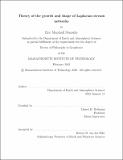| dc.contributor.advisor | Rothman, Daniel H. | |
| dc.contributor.author | Stansifer, Eric Marshall | |
| dc.date.accessioned | 2022-06-15T13:05:56Z | |
| dc.date.available | 2022-06-15T13:05:56Z | |
| dc.date.issued | 2022-02 | |
| dc.date.submitted | 2022-02-11T20:59:17.331Z | |
| dc.identifier.uri | https://hdl.handle.net/1721.1/143238 | |
| dc.description.abstract | Rivers self-organize into fractal river networks, with each river fed by smaller rivers, down to the scale of narrow rivulets. Certain groundwater-fed river networks develop stable and clearly delineated valley networks, which grow over time through headward erosion at the springheads. These networks exhibit non-linear dynamics, as their shape is a result of the groundwater flows, which itself depends on the shape of the networks. I explore the nature of this interdependence and ask, what consequences does it have on the shape of a river network?
The shape of a river network is not random, but is driven by physical processes whose behavior is local and mathematically simple. Starting from these local phenomena I seek to deduce global consequences about the network's shape.
This work is divided into two thematically-related parts:
First, considering a flat network such that headward erosion at the springheads maintains a locally symmetric groundwater field, I find a novel constraint connecting the rate of headward erosion to the shape of the network. This constraint theoretically allows us to determine the whole history of a network's evolution from its present shape. The results in this part are equally applicable to any Laplacian network driven by locally symmetric Laplacian growth.
Second, I consider the longitudinal profiles of a river network whose river slopes are sufficiently large to carry sediment downstream. This restriction on the profile of a river has implications on the development of new side branches. I find that side branches cannot form on inside curves of a main branch, as it would lose groundwater in competition to its parent. When the main branch is uncurved, I find that there is a minimum possible length a side branch can have, below which it is not prominent enough to attract the groundwater needed to sustain it. This acts as an obstacle to the formation of new side branches. | |
| dc.publisher | Massachusetts Institute of Technology | |
| dc.rights | In Copyright - Educational Use Permitted | |
| dc.rights | Copyright MIT | |
| dc.rights.uri | http://rightsstatements.org/page/InC-EDU/1.0/ | |
| dc.title | Theory of the growth and shape of Laplacian stream networks | |
| dc.type | Thesis | |
| dc.description.degree | Ph.D. | |
| dc.contributor.department | Massachusetts Institute of Technology. Department of Earth, Atmospheric, and Planetary Sciences | |
| dc.identifier.orcid | https://orcid.org/0000-0003-4894-3668 | |
| mit.thesis.degree | Doctoral | |
| thesis.degree.name | Doctor of Philosophy | |
